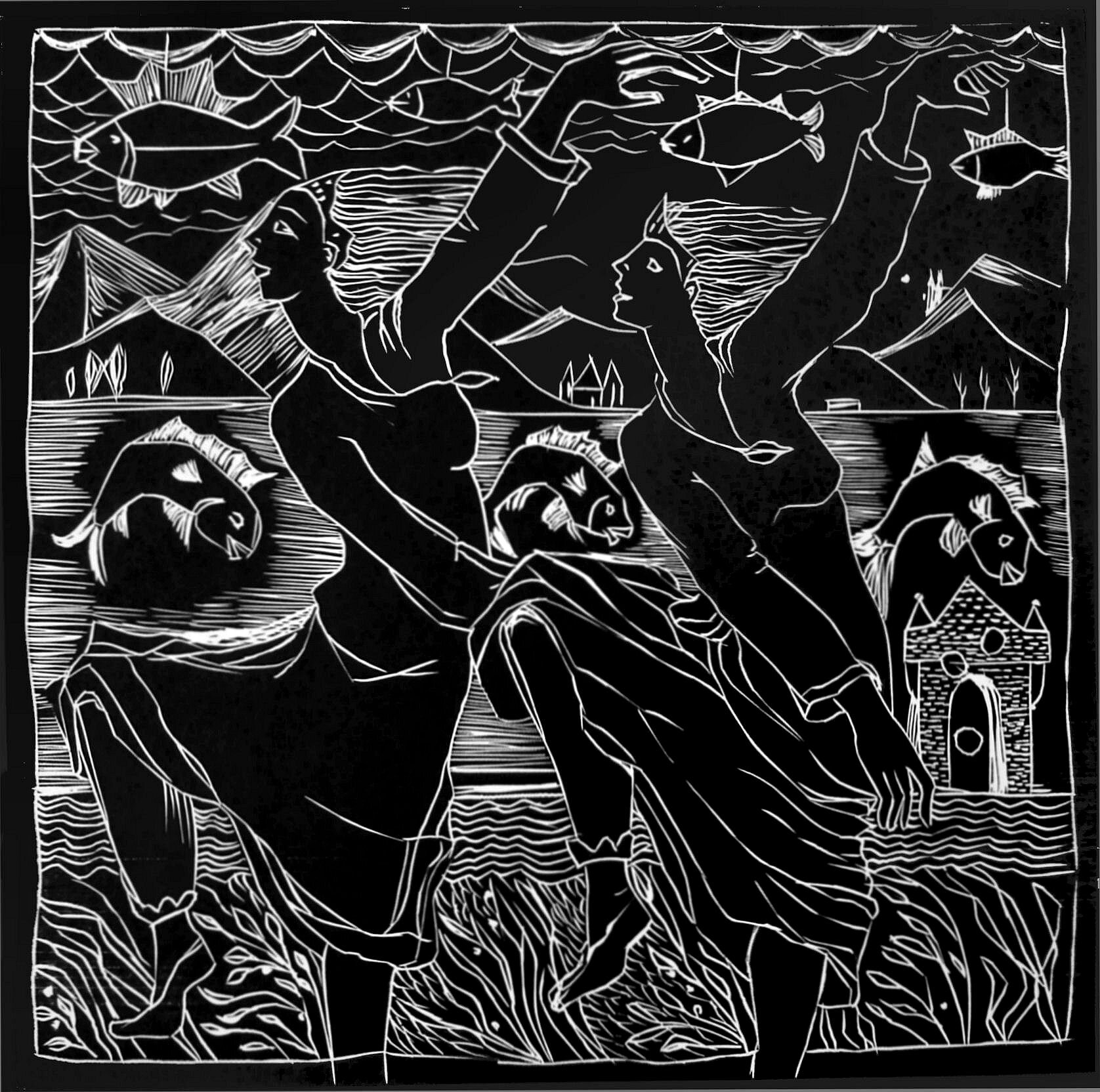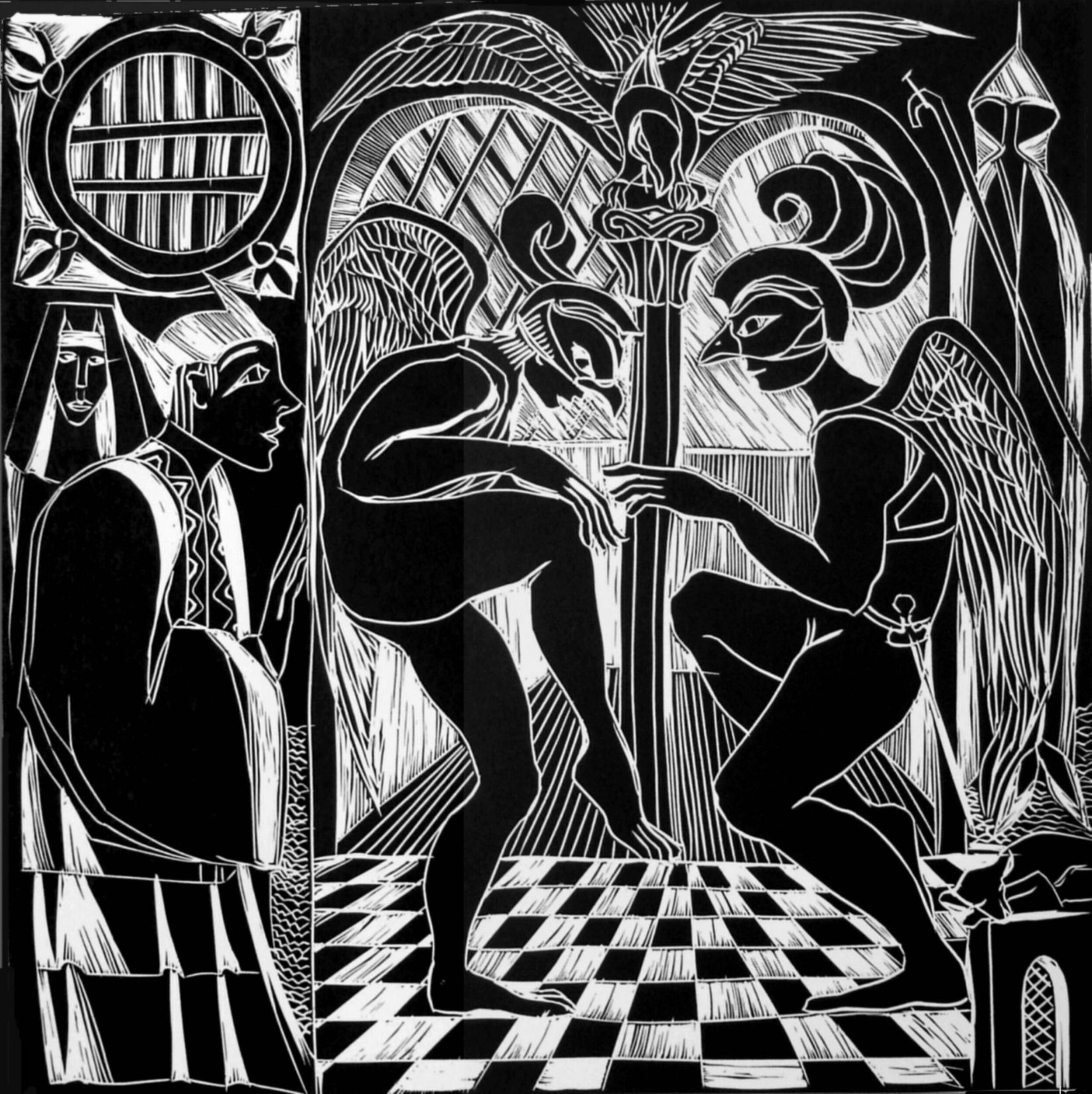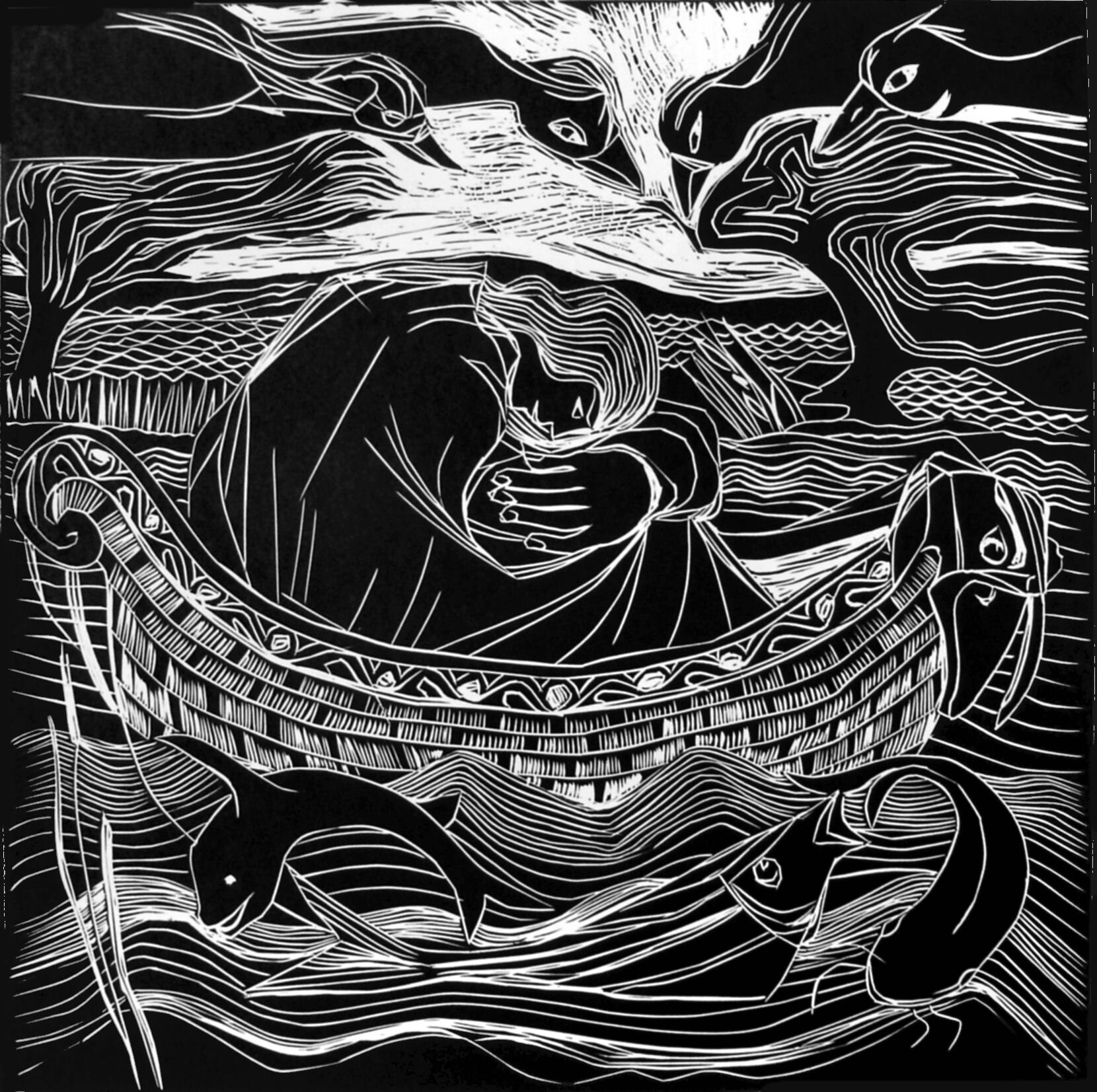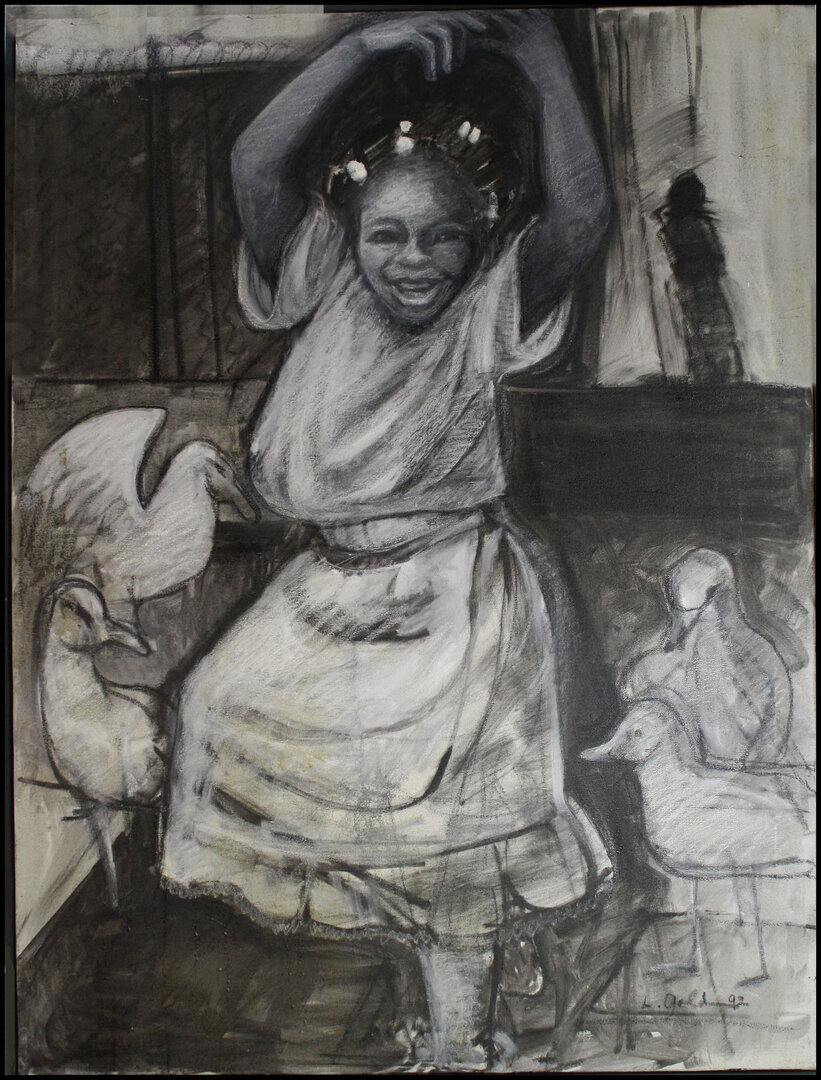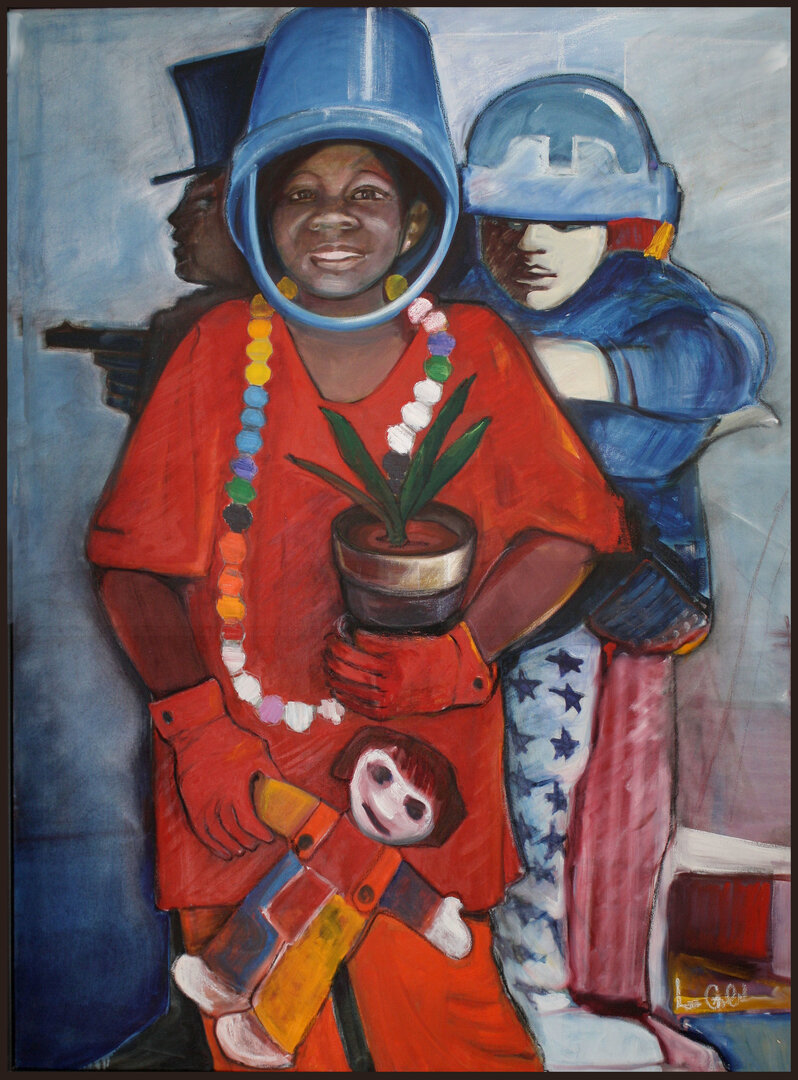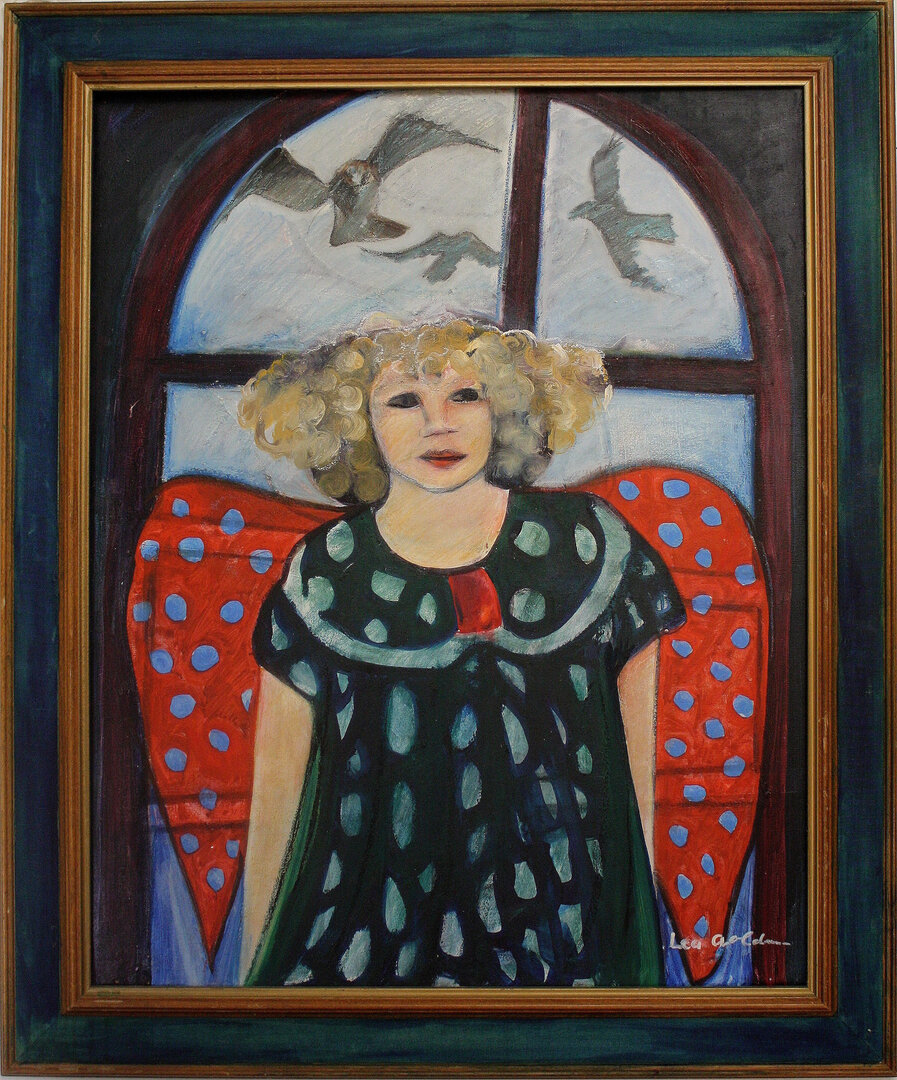Lea Goldman Canvas Story Teller
Lea Goldman fills her oil paintings with expanding depth and space. She is a storyteller expressing herself on canvases. Her paintings from a distance can appear two dimensional. Approaching the paintings, the flatness dissipates as you step into washes of color. In her layers of imagination you find a symbolic 3D affect playing across the canvas. Tapestries of dreamy images transport you through fabled stories and layers of meaning.
Goldman’s paintings of folk tale like characters and scenes reflect her rich history and multi-cultural influence while hinting at commentary from feminism, modern moralistic struggle, political controversy and mortality. Paintings of childhood joyfulness, glee, innocence and peace are set against themes of danger and darkness in a folkloric tableau.
Dance While You Can
Lea Goldman’s paintings hung in the South Bend Museum of Art Warner Gallery alongside Sarah Martin in the exhibit, Intertwined. Goldman refers to the larger part of her exhibition as Gathering Sparks.
Gathering Sparks is a culmination of more than fifty oil paintings by Goldman. The paintings are titled after the scholar Luria. In his philosophy there is a redemptive quality of life and the universe. In the creation process somehow sparks of goodness were shattered into pieces and scattered and hidden in the darkness. He thought if the goodness could be gathered, then the universe could be restored to its original goodness. To find out more about this the SBMA created a video where Douglas Simmons describes the philosophy eloquently for Goldman. You can also watch Lea Goldman give a short tour of the exhibition in the video. In her paintings you can see the goodness or sparks playout against the dark frightful suggestions of life.
“I am a full-time painter and printmaker. My work is narrative in nature with close attention to abstract elements such as composition, texture, and form. My interest in multi-cultural traditions, legends and folklore evolved into a personal mythology, constantly developing, and expressed in an array of art images and materials.” From Goldman’s web page. Goldman’s art has been shown widely throughout the United States, and regionally. She has been painting almost all her life. She tells a story when she first moved to Israel being asked to paint the walls of the school.
The Story Teller: When Dreams Come True (About Machines)
Elsye Speaks wrote of Goldman’s paintings, “There are no overt retellings of fairy tales, but the cast of characters that recur situate the viewers in that realm. As such, Goldman remakes the fairy tale as an infinitely adaptable and mutable. These works offer it (fairy tales) as a vehicle toward imagination and possibility.”
Bird Feeder’s Wake
Goldman says, “I am actually a storyteller. My art is like a story book page illustration on a large scale. These characters were my stories and I dressed them up and put stories around them. Slowly this allowed me to get into the depth of my expression.” You will see this depth in Goldman’s paintings, as there is more than one story line occurring in a painting. The multiple story lines play across the canvas with one another interacting in muted relationship.
Goldman describes a time when her art began to be inspired by the Italian theatre style of Commedia dell’arte 18th Century. Goldman built upon the art form to dress up characters in costume, and then place them into situations. Goldman feels that some of her most recent paintings reflect and apex in style and form derivation of the genesis idea. “This is the end result of me being able to dig into my psyche and bring it out courageously. You have to break through into your psyche in to bring about all of these ideas.” Goldman describes following the process or style of the commedia dell’arte as getting into herself and finding resources to develop her form. She utilizes her experiences from all over the world to play a part in the style, themes and shape of her art. Goldman says, “My paintings expand the way our minds expand into subconscious and symbolism.”
Conspiracy
Goldman explains how oils allow her to paint in layers. The layers play out in multiple styles in her paintings. “I use multi layers. Before completing the paintings, I add a wash that can make the entire composition more acceptable to the eye.” You can also see in Goldman’s paintings as “The Inner Guide” the tapestry of a second painting or theme playing over and within the theme of the first painting. These tapestries and themes sometimes appear ghost like. Her most creative use of the style is in the three series painting the “Story Teller.” (Cover photo for the magazine) In the three-panel series painting you see young people on the left and right appearing to be focused on the figures in the middle painting. While all around the children is a faint almost fog like swirl of a story unfolding.
The Maker
You rarely find just one theme in a Goldman painting. The mind jumps from form to symbol, juxtaposition to similarity attempting to create meaning from the story unfolding around a central theme and character. “There is contradiction in life,” says Goldman, “so there is in my painting.”
Departure
Goldman’s art in the Intertwined exhibit is represented in four collections Gathering Sparks, Diminutive fables (prints), Afternoon Hours (collage and poetry accompanied by calligraphy) and As I see It (collage).
In the collections Diminutive Fables and Afternoon Hours Goldman partners with local artists to create the art. Ann Binder takes Goldman’s poetry and with expertise in calligraphy adds an elegant touch to Goldman’s art.
While taking a course in print making Goldman created several plates based on her paintings and themes. Allen Larkin offered to help Goldman create prints from the etchings. Larkin developed a technique using hydraulic press to bring out the fine details of Goldman’s art.
Click on the picture to scroll through the slideshow. Prints from Goldman’s Diminutive Fables Series. Fisher Dance, Forbidden II, Riverboat.
“There is a very old legend that tells that when God created light, it was stored in an enormous container. But there was so much good light, and the goodness was so intense, that the container broke into endless pieces which turned into an endless number of sparks. This explains, according to the legend, why goodness is so fragmented, and the people of the world are so divided, and why there is so much suffering and war on Earth. The saga goes on to say that the duty of every conscious person is to gather those sparks of goodness and light and bond them back together into the great good. That is called in the Kabala “repairing the world,” one spark at a time. This was the goal of the alchemists. While manipulating metals, each person on his own, searching for the ultimate gold, the holy grail, was actually “collecting sparks, to repair the world.” Growing very old, running out of time, but still here, I paint big canvases. Like an alchemist, I hope that my creations will help me find the sparks of light around me. I wish to bring the sparks together into meaningful messages from places beyond cognition. By painting, I yearn to contribute my diminutive, humble share to the “gathering of sparks.”
Lead Me by Still Waters
“In my paintings I move away from common symbols. I move away from the habitual self and common symbols. I look for universal images. I think my art is a combination of all the places I have been. I have tried to keep my eyes open and let my mind totally absorb the culture where I am. Where I was born the art is heavily influenced by the middle ages and European influenced art. Maybe that’s my point of view? Raised in Mongolia influenced by European art. It is a wonderful multicultural experience that I have, and I think it is reflected in my art,” says Goldman.
“How much time do you have?” Lea Goldman asked me. I said, “I have several hours to spend with you.” What followed was an afternoon hearing Goldman’s rich history and receiving a personal tour of her art and thoughts. Following is a summary of the first part of our conversation.
“The dream of my parents was to come to the United States of America,” says Goldman. Goldman’s family ran from Romania to the Caspian. “We ran from place to place to place to place. They were not allowed to go to the United States because her mother was a Pioneer in Israel in the beginning of the century. (As a Pioneer) “They found a Russian book in her possession and the British accused her of being a spy. But she wasn’t really,” says Goldman. This was a time when the British tried to find any excuse to get people out of Israel. They would give the Pioneers a hard time because the Jewish were not welcome by the Arabs.
The British accused her of being a communist and exiled her from Israel. “She was accompanied by some gendarmes to a ship (where she was to be deported). My father was an officer on that ship. They put her under the care of my father, and they fell in love,” says Goldman. Two years after they married. They had a beautiful home on the shore Black Sea which was a small hotel her mother managed. Her father would go overseas to work.
My Inner Landscape- As I advance in age and the event of my mortality is undeniable, I become aware of the fact that death is not the end. There must be "something other" that cannot be found in any cognitive understanding. “I sense there is a life inside that is deep and wild and powerful, and connected to something vast” (Tracy Cohran). It is beyond the rush of life that carries me along like leaves on a stream. I am searching for clues on how to connect to that “something other.” I feel that there are hidden treasures there waiting to be discovered. This opening, the other kind of energy, is what I am searching for in my art. Beyond the exploration of the social concerns that preoccupy me, I am crossing over to another realm. - Lea Goldman
“When the war started my mother had to run away because Nazis occupied Romania and my father followed her. When my parents arrived in Russia they were separated,” says Goldman. Her mother had been taught Russian as a child in school. Her father only knew Hungarian and Romanian. The tragedy was because her father did not speak Russian, the Russians sent him as a suspect with German prisoners to work in the coal mines. He spent a great deal of the war in coal mines. Since her mother spoke beautiful Russian, she was paid to study communist ideas.
We still could not go to America. Goldman’s mother still had friends from her pioneer years in Israel. They traveled back to the Middle East. “We were one of the groups who tried to break the British Palestine Mandate.” ( https://en.wikipedia.org/wiki/1947_in_Mandatory_Palestine ) “We were traveling in a fisherman boat, but the British caught us right before we went into Israel.” There was a fight. The people on the boat threw potatoes as a defense, but there were six war ships surrounding them. “I will never forget the smells of the tear bombs they threw at us,” says Goldman. They took the family to Cyprus where they were building a refugee camp. The policy of the Hagenah was to flood Israel with Jewish survivors and refugees. More and more Jewish people tried to come to Israel.
“1920 and 1921 Arab riots - Believing that they could not rely on the British administration for protection from these gangs, the Jewish leadership created the Haganah to protect Jewish farms and kibbutzim. The first head of the Haganah was a 28 year-old named Yosef Hecht, a veteran of the Jewish Legion. “Wikipedia
Political Debate
Israel was recognized by the United Nations in 1948. The family were then allowed to go to Israel. “I was there for 27 years. My dream and my parent’s dream was to go to the United States of America. Being in the wars all my childhood I really wanted a place where there were no bombs flying overhead. As much as I loved Israel, I really wanted to come (to the United States). The idea of America was fascinating. The freedom of speech and creation,” says Goldman.
Joy
When she arrived in 1975, she wanted to know about African American and Latino cultures. “I was fortunate to have a job in Watts, Los Angeles the most notorious Nickerson Garden. I worked ten years as a teacher there learning about the people and culture.” She studied and took the Spanish fluency exam and worked ten more years with the Latino people. “I had a very rich exposure to the cultures which gave me great life experience, which is what I wanted to do,” Says Goldman.
Click on images to view four paintings by Goldman influenced by her time in Los Angeles.
“In Israel I only met my kind. By working with other cultures and other people showed me humanity that I was very curious to know. Because I was persecuted by another kind of people, I needed to expose myself socially to another world. To understand what another world was all about. I collected impressions with my art.”
by Dan Breen
The Little Light
The Story Teller is the cover art for PAN-O-PLY Story & Art Michiana







